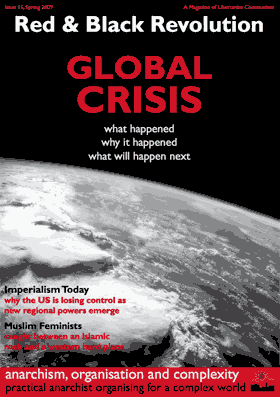Over 30 years of anarchist writing from Ireland listed under hundreds of topics
The development of the capitalist crisis 2008 to 2009
The first 18 months of the crash from the Credit Crunch to the spread to the 'real economy.
Financial Crisis August 2007 - September 2008
In August 2007 the world’s financial systems started grinding to a halt as financial institutions began to realise that they had no real idea of the risks that were contained within the complex financial instruments that they owned. Since the bankers couldn’t work out exactly how risky their own securities were, they certainly weren’t going to trust the assurances of other institutions. Due to the complexity of the inter-relationsshps within the financial sector, this resulted in the credit market basically shutting down. The financial institutions were no longer willing to lend money to any of their peers as they thought it was far too risky. This was known as the Credit Crunch.
As 2008 progressed, the credit market remained closed and it became ever more apparent that the reluctance of the bankers tomake loans to one another was well-founded.
In March 2008, Bear Stearns, one of the world’s largest investment banks, collapsed under the weight of its bad loans. Then, in September 2008, another Wall Street bank, Lehman Brothers, collapsed. Rather than bailing it out, or transferring its assets elsewhere, the US government allowed it to declare bankruptcy. This almost led to a total collapse of the global financial system, as Lehman’s bad debts rippled through it. Lehman’s bankruptcy shone a light on the vast web of deals between banks which meant that the entire system was dependent on the value of assets that were known to be ‘toxic’. As of March 2009, the financial system continues on a downward spiral - the injection of trillions of dollars of public money has merely slowed the collapse. The basic problem is that almost all of the banks are insolvent. The financial system is dead and will not be revived in the same form ever again.
Crisis in the Real Economy - September 2008 - Spring 2009
Although world stock-markets had been in retreat since November 2007, it wasn’t until September 2008 that the full effects of the crisis started to be felt in the real economy. There were two basic reasons for this spread. Firstly, it became more difficult for businesses to access credit. This was particularly problematic as, during the era of neoliberalism, it became standard practice for companies to borrow heavily in order to minimise the tax liabilities of their owners. Many businesses were heavily dependent on cheap credit and when it disappeared, they faced an immediate crisis and had to close or downsize to survive.
Secondly, the crisis was ultimately triggered by the fact that workers were unable to service their debts. This meant that there was going to be less consumer spending and companies were going to sell less products. This caused share prices to collapse and companies to cut back even further. These effects combined in a negative feedback loop - rising unemployment and less credit caused companies to cut back even further as spending collapsed, leading to a runaway economic crisis.
This article from Red & Black Revolution 15, Spring 2009 was first published as part of The neoliberal origins of the global capitalist crisis

This article was first published in
Red & Black Revolution 15, Spring 2009
[Download the PDF]

